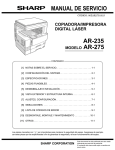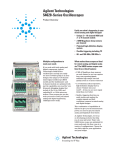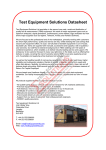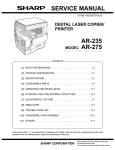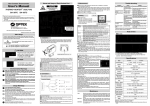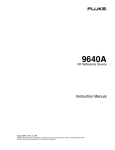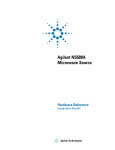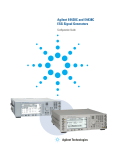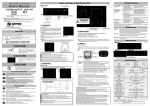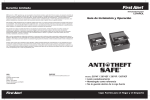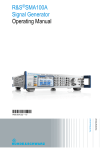Download Data Sheet - Electro Rent Corporation
Transcript
Migrate to the new Agilent MXG X-Series signal generator and generate true performance The new MXG exceeds the ESG’s performance in every category - output power, phase noise, spurious, and low frequency coverage to 9 kHz. Enjoy frequency and amplitude switching speeds that are 10 to 20 times faster, all in a compact, 3.5 inch (89 mm) tall unit. For more information visit www.agilent.com/find/X-Series_SG Agilent E4428C ESG Analog Signal Generator Data sheet All specifications apply over a 0 to 55 °C range (unless otherwise stated) and apply after a 45 minute warm-up time. Supplemental characteristics, denoted as typical, nominal, or measured, provide additional (non-warranted) information at 25 °C, which may be useful in the application of the product. Definitions Specifications: Represents warranted performance. Typical: Represents characteristic performance which is non-warranted. Describes performance that will be met by a minimum of 80% of all products. All typical values are indicated by parenthesis. Nominal: Represents characteristic performance which is non-warranted. Represents the value of a parameter that is most likely to occur; the expected mean or average. Measured: Represents characteristic performance which is non-warranted. Represents the value of a parameter measured on an instrument during design stage. Table of Contents Key Features . . . . . . . . . . . . . . . . . . . . . . . . . . . . . . . . . . . . . . . . . . . . . . . . . . . . . . . . . . . . . . 3 Specifications for Frequency and Power . . . . . . . . . . . . . . . . . . . . . . . . . . . . . . . . . . . . . . . 4 Frequency . . . . . . . . . . . . . . . . . . . . . . . . . . . . . . . . . . . . . . . . . . . . . . . . . . . . . . . . . . . . 4 Sweep modes . . . . . . . . . . . . . . . . . . . . . . . . . . . . . . . . . . . . . . . . . . . . . . . . . . . . . . . . 4 Internal reference oscillator . . . . . . . . . . . . . . . . . . . . . . . . . . . . . . . . . . . . . . . . . . . . . 4 Output power . . . . . . . . . . . . . . . . . . . . . . . . . . . . . . . . . . . . . . . . . . . . . . . . . . . . . . . . . 5 Spectral purity . . . . . . . . . . . . . . . . . . . . . . . . . . . . . . . . . . . . . . . . . . . . . . . . . . . . . . . . 9 Specifications for Analog Modulation . . . . . . . . . . . . . . . . . . . . . . . . . . . . . . . . . . . . . . . . 11 Frequency bands . . . . . . . . . . . . . . . . . . . . . . . . . . . . . . . . . . . . . . . . . . . . . . . . . . . . . 11 Frequency modulation . . . . . . . . . . . . . . . . . . . . . . . . . . . . . . . . . . . . . . . . . . . . . . . . . 11 Phase modulation . . . . . . . . . . . . . . . . . . . . . . . . . . . . . . . . . . . . . . . . . . . . . . . . . . . . 12 Amplitude modulation . . . . . . . . . . . . . . . . . . . . . . . . . . . . . . . . . . . . . . . . . . . . . . . . . 13 Wideband AM . . . . . . . . . . . . . . . . . . . . . . . . . . . . . . . . . . . . . . . . . . . . . . . . . . . . . . . 14 Pulse modulation . . . . . . . . . . . . . . . . . . . . . . . . . . . . . . . . . . . . . . . . . . . . . . . . . . . . . 14 Internal analog modulation source . . . . . . . . . . . . . . . . . . . . . . . . . . . . . . . . . . . . . . 15 External modulation inputs . . . . . . . . . . . . . . . . . . . . . . . . . . . . . . . . . . . . . . . . . . . . . 15 Composite modulation . . . . . . . . . . . . . . . . . . . . . . . . . . . . . . . . . . . . . . . . . . . . . . . . 16 Simultaneous modulation . . . . . . . . . . . . . . . . . . . . . . . . . . . . . . . . . . . . . . . . . . . . . . 16 General Characteristics . . . . . . . . . . . . . . . . . . . . . . . . . . . . . . . . . . . . . . . . . . . . . . . . . . . . 17 Operating characteristics . . . . . . . . . . . . . . . . . . . . . . . . . . . . . . . . . . . . . . . . . . . . . . 17 Accessories . . . . . . . . . . . . . . . . . . . . . . . . . . . . . . . . . . . . . . . . . . . . . . . . . . . . . . . . . 18 Inputs and outputs . . . . . . . . . . . . . . . . . . . . . . . . . . . . . . . . . . . . . . . . . . . . . . . . . . . 18 Ordering Information . . . . . . . . . . . . . . . . . . . . . . . . . . . . . . . . . . . . . . . . . . . . . . . . . . . . . . 21 Related Literature . . . . . . . . . . . . . . . . . . . . . . . . . . . . . . . . . . . . . . . . . . . . . . . . . . . . . . . . . 22 2 Key Features Key standard features Optional performance • Industry-leading spectral purity • Superior level accuracy • High output power • High-stability timebase • Wideband FM and ΦM • Excellent modulation accuracy and stability • Step and list sweep, both frequency and power • Built-in function generator • Lightweight, rack-mountable • 2-year calibration cycle • Option 503, frequency range from 250 kHz to 3 GHz (electronic attenuator standard) • Option 506, frequency range from 250 kHz to 6 GHz (mechanical attenuator only) • Option UNB, higher output with mechanical attenuator Note: Option 506 is standard with the high power mechanical attenuator used in Option UNB, and therefore, both options cannot be ordered together. • Option 1EM, move all front panel connectors to rear panel 3 Specifications for Frequency and Power Frequency Frequency range Option 503 506 250 kHz to 3 GHz [electronic attenuator standard] 250 kHz to 6 GHz [mechanical attenuator only] Frequency minimum 100 kHz1 Frequency resolution 0.01 Hz Frequency switching speed Option 503 Freq.2 Freq./Amp.3 (< 9 ms) (< 9 ms) [For hops < 5 MHz within a band] (< 9 ms) (< 9 ms) Phase offset Sweep modes Option 506 Freq.2Freq./Amp.3 (< 16 ms) (< 17 ms) (< 12 ms) (< 14 ms) Phase is adjustable remotely [LAN, GPIB, RS-232] or via front panel in nominal 0.1 ° increments Operating modes Frequency step, amplitude step and arbitrary list Dwell time 1 ms to 60 s Number of points 2 to 65,535 (Step) 2 to 1601 (List) Internal reference oscillator Stability Aging rate < ±0.1 ppm/yr or < ±0.0005 ppm/day after 45 days Temp [0 to 55 °C] (< ±0.05 ppm) Line voltage (< ±0.002 ppm) Line voltage range (+5% to –10%) RF reference input requirements Frequency 1, 2, 5, 10 MHz ±0.2 ppm RF reference output Frequency Amplitude 1. Performance below 250 kHz not guaranteed. 2. To within 0.1 ppm of final frequency above 250 MHz or within 100 Hz below 250 MHz. 3. Frequency switching time with the amplitude settled within ±0.1 dB. 4 10 MHz 4 dBm ±2 dB Specifications for Frequency and Power PowerOption UNB Option 503 Option 503 250 kHz to 250 MHz +11 to –136 dBm +15 to –136 dBm > 250 MHz to 1 GHz +13 to –136 dBm +17 to –136 dBm > 1 to 3 GHz +10 to –136 dBm +16 to –136 dBm > 3 to 6 GHz N/A N/A Option 506 +12 to –136 dBm +14 to –136 dBm +13 to –136 dBm +10 to –136 dBm Maximum available power (measured) 26 24 Option UNB 22 Power [dB] Output power Option 506 20 18 16 14 Option 503 12 10 0 1000 2000 3000 4000 5000 6000 Frequency [MHz] Level resolution 0.02 dB Level range with Attenuator Hold active Option 503 250 kHz to 1 GHz 23 dB > 1 to 3 GHz 20 dB > 3 to 6 GHz N/A Option UNB Option 503 27 dB 26 dB N/A Option 506 24 dB 23 dB 20 dB 5 Specifications for Frequency and Power Level accuracy [dB] Option 503 1 +7 to –50 dBm 250 kHz to 2.0 GHz ±0.5 2.0 to 3 GHz ±0.6 Power level –50 to –110 to –110 dBm –127 dBm ±0.5 ±0.7 ±0.6 ±0.8 Option UNB 2 +10 to –50 dBm 250 kHz to 2.0 GHz ±0.5 2.0 to 3 GHz ±0.6 Power level –50 to –110 to –110 dBm –127 dBm ±0.7 ±0.8 ±0.8 ±1.0 Option 506 3 +7 to –50 dBm 250 kHz to 2.0 GHz ±0.6 2.0 to 3 GHz ±0.6 3 to 4 GHz ±0.8 4 to 6 GHz ±0.8 Power level –50 to –110 to –110 dBm –127 dBm ±0.8 ±0.8 ±0.8 ±1.0 ±0.9 ±1.5 ±0.9 (±1.5) Option 503 Levelat Accuracy at -110 dBm (Measured) Option 503 level accuracy –110 dBm (measured) 1 0.8 0.8 0.6 0.6 0.4 0.4 0.2 0.2 0 –0.2 –0.4 –0.4 –0.6 –0.6 –0.8 –0.8 0 500 1000 1500 2000 2500 3000 –1 0 1000 2000 3000 Frequency (MHz) (±1.5) (±2.5) < –127 dBm (±1.5) (±2.5) (±2.5) 5000 6000 7000 Note: Special Option HF8 is required for frequency capability up to 7 GHz (±0.15 dB) [relative to ALC on] After power search is executed. Level switching speed Option 503 Normal operation [ALC on] (< 15 ms) When using power search manual (< 83 ms) When using power search auto (< 103 ms) 6 < –127 dBm 4000 Frequency (MHz) Level accuracy with ALC off Conditions: 1. 2. 3. (±1.5) (±2.5) 0 –0.2 –1 < –127 dBm Option 506 Level dBm (Measured) Option 506 level accuracy atAccuracy –110at –110 dBm (measured) 1 Error (dB) Error (dB) Option UNB Option 503 (< 21 ms) (< 95 ms) (< 119 ms) Option 506 (< 21 ms) (< 95 ms) (< 119 ms) Quoted specifications for 23 °C ±5 °C. Accuracy degrades by less than 0.03 dB/°C over full temperature range. Accuracy degrades by 0.3 dB above +7 dBm, and by 0.8 dB above +10 dBm. Quoted specifications for 23 °C ±5 °C. Accuracy degrades by less than 0.03 dB/°C over full temperature range. Accuracy degrades by 0.2 dB above +10 dBm, and by 0.8 dB above +13 dBm. Quoted specifications for 23 °C ±5 °C. Accuracy degrades by less than 0.02 dB/°C over full temperature range. Accuracy degrades by 0.2 dB above +7 dBm. Specifications for Frequency and Power Repeatability and linearity Repeatability 1900 MHz CW, 5 dBm, attenuator hold On, ALC On 0.1 0.5 0.09 0.45 Typical unit Limits 0.08 0.4 0.07 0.35 0.06 0.3 Power error (dB) Powererror (dB) Repeatability 1900 MHz CW, 5 dBm, attenuator hold Off, ALC Off 0.05 0.04 0.25 0.2 0.03 0.15 0.02 0.10 0.01 0.05 0 0 20 40 Typical unit Limits 0 60 100 80 1 0 120 2 3 Elapsed time (minutes) 4 5 6 7 8 9 10 Elapsed time (minutes) Repeatability measures the ability of the instrument to return to a given power setting after a random excursion to any other frequency and power setting. It is a relative measurement that reflects the difference in dB between the maximum and minimum power readings for a given setting over a specific time interval. It should not be confused with absolute power accuracy, which is measured in dBm.1 Relative level accuracy Initial power 7 dBm 0.4 Lower limit Lower STD deviation Mean Upper STD deviation Upper limit 0.3 0.2 Power error (dB) 0.1 0 -0.1 -0.2 -0.3 -0.4 0 -20 -40 -60 -80 -100 -120 -140 Final power (dBm) Relative level accuracy measures the accuracy of a step change from any power level to any other power level. This is useful for large changes (i.e. 5 dB steps).1 1. Repeatability and relative level accuracy are typical for all frequency ranges. 7 Specifications for Frequency and Power Linearity CW, 850 MHz, attenuator hold On, ALC On 0.3 Typical Option 503 unit Typical Option UNB unit Typical Option 506 unit 0.25 0.2 0.15 Lower limit Upper limit 0.1 ALC offset error (dB) Linearity measures the accuracy of small changes while the attenuator is held in a steady state (to avoid power glitches). This is useful for fine resolution changes.1 0.05 0 -0.05 -0.1 -0.15 -0.2 -0.25 Limit is undefined above 13 dBm for Option 503 units. Limit line applies only to UNB and 506 units. -0.3 -0.35 -0.4 -10 -8 -6 -4 -2 0 2 4 6 8 10 12 14 16 Amplitude (dBm) Linearity CW, 1900 MHz, attenuator hold On, ALC On Linearity CW 5750 MHz, attenuator hold On, ALC On 0.3 0.3 0.25 Typical Option 503 unit Typical Option UNB unit Typical Option 506 unit Lower limit Upper limit 0.2 0.1 0.2 0.15 ALC offset error (dB) ALC offset error (dB) 0.15 0.05 0 -0.05 -0.1 -0.15 0.1 0.05 0 -0.05 -0.1 -0.15 -0.2 -0.2 -0.25 -0.25 -0.3 -0.3 -10 -8 -6 -4 -2 0 2 4 6 8 10 12 14 Amplitude (dBm) 1. Repeatability and relative level accuracy are typical for all frequency ranges. 8 Lower limit Upper limit Mean, Option 506 unit Lower Option 503 deviation Upper Option 503 deviation 0.25 16 -10 -8 -6 -4 -2 0 2 amplitude (dBm) 4 6 8 10 Specifications for Frequency and Power Spectral purity SSB Phase noise [at 20 kHz offset] at 500 MHz < –135 dBc/Hz, (< –138 dBc/Hz) at 1 GHz < –130 dBc/Hz, (< –134 dBc/Hz) at 2 GHz < –124 dBc/Hz, (< –128 dBc/Hz) at 3 GHz < –121 dBc/Hz, (< –125 dBc/Hz) at 4 GHz < –118 dBc/Hz, (< –122 dBc/Hz) at 6 GHz < –113 dBc/Hz, (< –117 dBc/Hz) Residual FM [CW mode, 0.3 to 3 kHz BW, CCITT, rms] < N x 1 Hz (< N x 0.5 Hz)1 Harmonics2 [output level ≤ +4 dBm Option 503, ≤ +7.5 dBm Option UNB, ≤ +4.5 dBm Option 506] < –30 dBc above 1 GHz, (< –30 dBc 1 GHz and below) Nonharmonics3 [≤ +7 dBm output level decreases, ≤ +4 dBm Option 506] 4 1. 2. 3. 4. 5. 6. 250 kHz to 250 MHz 250 MHz to 500 MHz 500 MHz to 1 GHz 1 to 2 GHz 2 to 4 GHz 4 to 6 GHz > 3 kHz offset < –65 dBc < –80 dBc < –80 dBc < –74 dBc < –68 dBc < –62 dBc Subharmonics ≤ 1 GHz > 1 GHz None None > 10kHz offset (< –58 dBc) < –80 dBc < –80 dBc < –74 dBc < –68 dBc < –62 dBc Jitter in µUI 5,6 Carrier frequency 155 MHz 622 MHz 2.488 GHz SONET/SDH data rates 155 MB/s 622 MB/s 2488 MB/s rms jitter bandwidth 100 Hz to 1.5 MHz 1 kHz to 5 MHz 5 kHz to 15 MHz Jitter in seconds Carrier frequency 155 MHz 622 MHz 2.488 GHz SONET/SDH data rates 155 MB/s 622 MB/s 2488 MB/s rms jitter bandwidth 100 Hz to 1.5 MHz 1 kHz to 5 MHz 5 kHz to 15 MHz (µUI rms) (78) (46) (74) (0.6 ps) (74 fs) (30 fs) Refer to frequency bands on page 11 for N values. Harmonic performance outside the operating range of the instrument is typical. Spurs outside the operating range of the instrument are not specified. Specifications apply for CW mode only. Calculated from phase noise performance in CW mode only at -2.5 dBm for Option 503 instruments, -0.5 dBm with Option 506, and +2.5 dBm with Option UNB. For other frequencies, data rates, or bandwidths, wplease contact your sales representative. 9 Specifications for Frequency and Power Characteristic SSB phase noise (measured) CW mode CW mode fc = 850 MHz fc = 5.7 GHz [Option 506] PN mode 1 PN mode 2 CW mode fc = 1900 MHz Phase noise modes 1 and 2 at fc = 900 MHz –60 –70 –80 –90 –100 –110 –120 –130 –140 –150 –160 10 100 1K 10K 100K 1M 10M L(f) (dBc/Hz) vs. f (Hz) fc = 1000 MHz CW mode fc = 2200 MHz 10 Specifications for Analog Modulation Frequency bands Frequency modulation1 Band 1 2 3 4 5 6 Frequency range N number 250 kHz to ≤ 250 MHz 1 > 250 MHz to ≤ 500 MHz 0.5 > 500 MHz to ≤ 1GHz 1 > 1 to ≤ 2 GHz 2 > 2 to ≤ 4 GHz 4 > 4 to ≤ 6 GHz 8 Maximum deviation 2 Resolution N x 1 MHz 0.1% of deviation or 1 Hz, whichever is greater Modulation frequency rate [deviation = 100 kHz] Coupling 1 dB bandwidth 3 dB bandwidth (DC to 10 MHz) (DC to 0.9 MHz) (5 Hz to 10 MHz) (5 Hz to 0.9 MHz) FM path 1[DC] FM path 2 [DC] FM path 1 [AC] FM path 2 [AC] DC to 100 kHz DC to 100 kHz 20 Hz to 100 kHz 20 Hz to 100 kHz Deviation accuracy2 [1 kHz rate, deviation < N x 100 kHz] < ± 3.5% of FM deviation + 20 Hz Carrier frequency accuracy relative to CW in DCFM2,3 ±0.1% of set deviation + (N x 1 Hz) Distortion2 [1 kHz rate, dev.= N x 100 kHz] < 1% FM using external inputs 1 or 2 Sensitivity 1 Vpeak for indicated deviation Input impedance 50 Ω, nominal FM path 1 and FM path 2 are summed internally for composite modulation. The FM 2 path is limited to a maximum rate of 1 MHz. The FM 2 path must be set to a deviation less than FM 1 path. 1. All analog performance above 3 GHz is typical. 2. Refer to frequency bands on this page to compute specifications. 3. At the calibrated deviation and carrier frequency, within 5 °C of ambient temperature at time of calibration. 11 Specifications for Analog Modulations Phase modulation1 Resolution 0.1% of set deviation Modulation frequency response2 Mode Normal BW High BW Maximum deviation N x 10 radians N x 1 radians Allowable rates [3 dB BW] ØM path 1 ØM path 2 DC to 100 kHz DC to 100 kHz (DC to 1 MHz) (DC to 0.9 MHz) Deviation accuracy [1 kHz rate, Normal BW mode] < ±5% of deviation + 0.01 radians Distortion 2 [1 kHz rate, deviation, < 10N radians, Normal BW mode] < 1% ØM using external inputs 1 or 2 Sensitivity 1 Vpeak for indicated deviation 50 Ω, nominal Input impedance Paths 1. All analog performance above 3 GHz is typical. 2. Refer to frequency bands on page 11 for N. 3. Bandwidth is automatically selected based on deviation. 12 ØM path 1 and ØM path 2 are summed internally for composite modulation. The ØM 2 path is limited to a maximum rate of 1 MHz. ØM path 2 must be set to a deviation less than the ØM path 1. Specifications for Analog Modulations Amplitude modulation1, 2 [fc > 500 kHz] Range 0 to 100% Resolution 0.1% Rates [3 dB bandwidth] DC coupled 0 to 10 kHz AC coupled 10 Hz to 10 kHz Accuracy 2,3 1 kHz rate < ±(6% of setting +1%) Distortion2,3 [1 kHz rate, THD] Option 503 30% AM < 1.5% 90% AM (< 4%) Option 506 < 1.5% (< 5%) AM using external inputs 1 or 2 Sensitivity 1 Vpeak to achieve indicated depth 50 Ω, nominal Input impedance Paths AM path 1 and AM path 2 are summed internally for composite modulation. 1. All analog performance above 3 GHz is typical. 2. AM is typical above 3 GHz. 3. Peak envelope power of AM must be 3 dB less than maximum output power below 250 MHz. 13 Specifications for Analog Modulation Pulse modulation On/off ratio ≤ 4 GHz > 4 GHz > 80 dB (> 64 dB) Rise/fall times (150 ns) Minimum width ALC on ALC off (2 µs) (0.4 µs) Pulse repetition frequency ALC on (10 Hz to 250 kHz) ALC off (DC to 1.0 MHz) Level accuracy1 [relative to CW at ≤ 4 dBm Option 503, ≤ 7.5 dBm Option UNB, ≤ 4.5 dBm Option 506] (< ±1 dB) Pulse modulation using external inputs Input voltage RF on > +0.5 V, nominal RF off < +0.5 V, nominal Input impedance 50 Ω, nominal Internal pulse generator Square wave rate 0.1 Hz to 20 kHz Pulse Period 8 µs to 30 seconds Width 4 µs to 30 seconds Resolution 2 µs 1. With ALC off, specifications apply after the execution of power search. With ALC on, specifications apply for pulse repetition rates ≤ 10 kHz and pulse widths ≥ 5 µs. 14 Specifications for Analog Modulation Internal analog modulation source [Provides FM, AM, pulse, and phase modulation signals and LF audio out] Waveforms sine, square, ramp, triangle, pulse, noise Rate range Sine Square, ramp, triangle 0.1 Hz to 100 kHz 0.1 Hz to 20 kHz Resolution 0.1 Hz Frequency accuracy same as RF reference source Swept sine mode [frequency, phase continuous] Operating modes Triggered or continuous sweeps Frequency range 0.1 Hz to 100 kHz Sweep time 1 ms to 65 sec Resolution 1 ms Dual sinewave mode Frequency range 0.1 Hz to 100 kHz Amplitude ratio 0 to 100% Amplitude ratio resolution 0.1% LF audio out mode Amplitude 0 to 2.5 Vpeak into 50 Ω 50 Ω nominal Output impedance Noise Noise with adjustable amplitude generated as a peak-to-peak value (RMS value is approximately 80% of displayed value) External modulation inputs Modulation types Ext 1 Ext 2 FM, ØM, AM, pulse FM, ØM, AM, and pulse High/Low Indicator [100 Hz to 10 MHz BW, AC coupled inputs only]. Activated when input level error exceeds 3% [nominal]. 15 Specifications for Analog Modulation Composite modulation Simultaneous modulation 16 AM, FM, and ØM each consist of two modulation paths which are summed internally for composite modulation. The modulation sources may be any two of the following: Internal, External 1, External 2. Multiple modulation types may be simultaneously enabled. For example, AM, and FM can run concurrently and all will affect the output RF. This is useful for simulating signal impairments. There are some exceptions: FM and ØM cannot be combined. Two modulation types cannot be generated simultaneously by the same modulation source. General Characteristics Operating characteristics Power requirements 90 to 254 V; 50 or 60 Hz; 300 W maximum, power factor corrected. Not for 400 Hz use.1 Operating temperature range2 0 to 55 °C Storage temperature range –40 to 70 °C Shock and vibration Meets MIL-STD-28800E Type III, Class 3. Leakage Conducted and radiated emissions conform to CISPR 11. Leakage is typically < 1 µV [nominally 0.1 µV with a 2-turn loop] at ≤ 1000 MHz, measured with a resonant dipole antenna, one inch from any surface with output level < 0 dBm [all inputs/outputs properly terminated]. Storage registers Memory is shared by instrument states, user data files, sweep list files and waveform sequences. Depending on the number and size of these files, up to 100 storage registers and 1000 register sequences [10 per register] are available. Weight < 16 kg [35 lb.] net, < 23 kg [50 lb.] shipping Dimensions 133 mm H x 426 mm W x 432 mm D [5.25 in H x 16.8 in W x 17 in D] Remote programming Interface Control languages3 Functions controlled GPIB [IEEE-488.2-1987] with listen and talk, RS-232, LAN [10BaseT]. SCPI version 1996.0, also compatible with 8662A, 8663A, 8656B and 8657A/B/C/D/J1 mnemonics. All front panel functions except power switch and knob. ISO compliant The E4428C ESG is manufactured in an ISO-9001 registered facility in concurrence with Agilent Technologies commitment to quality. Reverse power protection 250 kHz to 2 GHz > 2 to 4 GHz > 4 to 6 GHz Max DC voltage Option 503 47 dBm 44 dBm N/A 40 V Option 506 30 dBm 30 dBm 30 dBm SWR 250 kHz to 2.2 GHz > 2.2 GHz to 3 GHz > 3 GHz to 4 GHz > 4 GHz to 6 GHz Option 503 (< 1.5:1) (< 1.4:1) (< 1.5:1) N/A Option UNB (< 1.5:1) (< 1.5:1) (< 1.7:1) N/A Output impedance 50 Ω nominal Option 506 (< 1.6:1) (< 1.4:1) (< 1.7:1) (< 1.8:1) 1. For 400 Hz systems, order transformer 70001-60066. 2. Save and recall of user files and instrument states from non-volatile storage is guaranteed only over the range 0 to 40 °C. 3. ESG series does not implement 8657A/B “Standby” or “On” [R0 or R1, respectively] mnemonics. 17 General Characteristics Accessories Inputs and outputs All front panel connectors can be moved to rear with Option 1EM. Transit case 10 MHz input 10 MHz output Part number 9211-1296 Accepts a 1, 2, 5, or 10 MHz ±0.2 ppm. Nominal input level –3.5 to +20 dBm, impedance 50 ohms. [BNC, rear panel] Outputs the 10 MHz reference signal. Level nominally +3.9 dBm ±2 dB. Nominal output impedance 50 ohms. [BNC, rear panel] External 1 input This BNC input connector accepts a ±1 Vpeak signal for AM, FM, pulse, and phase modulation. For all these modulations, ±1 Vpeak produces the indicated deviation or depth. When ac-coupled inputs are selected for AM, FM, or phase modulation and the peak input voltage differs from 1 Vpeak by more than 3%, the hi/lo annunciator light on the display. The input impedance is 50 ohms and the damage levels are 5 Vrms and 10 Vpeak.. If you configure your signal generator with Option 1EM, this input is relocated to a female BNC connector on the rear panel. External 2 input This BNC input connector accepts a ±1 Vpeak signal for AM, FM, phase modulation, and pulse modulation. With AM, FM, or phase modulation, ±1 Vpeak produces the indicated deviation or depth. With pulse modulation, +1 V is on and 0 V is off. When ac-coupled inputs are selected for AM, FM, or phase modulation, and the peak voltage differs from 1 Vpeak by more than 3%, the hi/lo annunciator light on the display. The input impedance is 50 ohms and the damage levels are 5 Vrms and 10 Vpeak If you configure your signal generator with Option 1EM, this input is relocated to a female BNC connector on the rear panel. GPIB Allows communication with compatible devices. [rear panel] LF output Outputs the internally-generated LF source. Outputs 0 to 2.5 Vpeak into 50 ohms, or 0 to 5 Vpeak into high impedance. [BNC, front panel] RF output Nominal output impedance 50 ohms. [type-N female, front panel] Sweep output Trigger input Trigger output Generates output voltage, 0 to +10 V when signal generator is sweeping. Output impedance < 1 ohm, can drive 2000 ohms. [BNC, rear panel] Accepts CMOS1 signal for triggering point-to-point in manual sweep mode, or to trigger start of LF sweep. The damage levels are –0.5 to +5.5 V. [BNC, rear panel] Outputs a TTL signal: high at start of dwell, or when waiting for point trigger in manual sweep mode; low when dwell is over or point trigger is received, high or low 2 μs pulse at start of LF sweep. [BNC, rear panel] 1. Rear panel inputs and outputs are 3.3 V CMOS, unless indicated otherwise. CMOS inputs will accept 5 V CMOS, 3 V CMOS, or TTL voltage levels. 18 General Characteristics LAN connector LAN communication is supported by the signal generator via the LAN connector. It is functionally equivalent to the GPIB connector. The LAN connector enables the signal generator to be remotely programmed by a LAN-connected computer. The distance between a computer and the signal generator is limited to 100 meters [10BaseT]. For more information about the LAN, refer to the Getting Started chapter in the Programming Guide. Data transfer speeds LAN [FTP] file transfer to volatile memory to hard drive LAN [SCPI] command transfer to volatile memory to hard drive Internal file transfer from hard drive to volatile memory (700 KB/sec) (500 KB/sec) (146 KB/sec) (128 KB/sec) (1280 KB/sec) RS-232 connector This male DB-9 connector is an RS-232 serial port that can be used for controlling the signal generator remotely. It is functionally equivalent to the GPIB connector. The following table shows the description of the pinouts. The pin configuration is shown below. Pin number 1 2 3 4 5 6 7 8 9 5 Signal description No connection Receive data Transmit data +5 V Ground, 0 V No connection Request to send Clear to send No connection 4 9 3 8 2 7 Signal name RECV XMIT RTS CTS 1 6 View looking into rear panel connector 19 Ordering Information 1 Frequency options Performance enhancement options • E4428C-503 • E4428C-506 250 kHz to 3 GHz frequency range [electronic attenuator standard] 250 kHz to 6 GHz frequency range [mechanical attenuator only] • E4428C-UNB High output power with mechanical attenuator Note: Option 506 is standard with the high power mechanical attenuator used in Option UNB, and therefore, both options cannot be ordered together. • E4428C-1EM Moves all front panel connectors to rear Manual and accessories • E4428C-1CM • E4428C-1CP • E4428C-1CN • E4428C-CD1 • E4428C-ABA • E4428C-0BW • E4428C-UK6 Warranty and calibration plans For more information, please visit: www.agilent.com/find/removealldoubt. Rack mount kit without handles Rack mount kit with handles Front handle kit CD-ROM of English user guide and assembly level service manual (standard with instrument) Printed English documentation set Service documentation, assembly level Commercial calibrations certificate with test data • Extended return-to-Agilent warranty and service • Agilent calibration upfront plan • Agilent calibration plus upfront plan • Z540 calibration upfront plan 1. All options should be ordered using E4428C-xxx, where the xxx represents the option number. 20 Related Literature • Signal Generator Spectral Purity Considerations in RF Communications Testing, Application Note 388, Literature Number 5952-2019. •RF Source Basics, a self-paced tutorial (CD-ROM), Literature Number 5980-2060E. •IntuiLink Software, Data Sheet, Literature Number 5980-3115EN. •Security of Agilent Signal Generators: Issues and Solutions, Application Note, Literature Number 5989-1091EN. 21 www.agilent.com Additional Resources See the ESG Web page Get the latest news, product and support information, application literature, firmware upgrades and more. Agilent’s Internet address for the ESG is: www.agilent.com/find/esg For more information on Agilent Technologies’ products, applications or services, please contact your local Agilent office. The complete list is available at: Agilent Advantage Services is committed to your success throughout your equipment’s lifetime. To keep you competitive, we continually invest in tools and processes that speed up calibration and repair and reduce your cost of ownership. You can also use Infoline Web Services to manage equipment and services more effectively. By sharing our measurement and service expertise, we help you create the products that change our world. www.agilent.com/find/advantageservices www.agilent.com/quality Agilent Email Updates www.agilent.com/find/emailupdates Get the latest information on the products and applications you select. www.agilent.com/find/contactus Americas Canada Brazil Mexico United States Asia Pacific Australia 1 800 629 485 China 800 810 0189 Hong Kong 800 938 693 India 1 800 112 929 Japan 0120 (421) 345 Korea 080 769 0800 Malaysia 1 800 888 848 Singapore 1 800 375 8100 Taiwan 0800 047 866 Other AP Countries (65) 375 8100 Europe & Middle East Belgium 32 (0) 2 404 93 40 Denmark 45 45 80 12 15 Finland 358 (0) 10 855 2100 France 0825 010 700* Agilent Channel Partners www.agilent.com/find/channelpartners Get the best of both worlds: Agilent’s measurement expertise and product breadth, combined with channel partner convenience. (877) 894 4414 (11) 4197 3600 01800 5064 800 (800) 829 4444 *0.125 €/minute Germany 49 (0) 7031 464 6333 Ireland 1890 924 204 Israel972-3-9288-504/544 Italy 39 02 92 60 8484 Netherlands 31 (0) 20 547 2111 Spain 34 (91) 631 3300 Sweden 0200-88 22 55 United Kingdom 44 (0) 118 927 6201 For other unlisted countries: www.agilent.com/find/contactus Revised: January 6, 2012 Product specifications and descriptions in this document subject to change without notice. © Agilent Technologies, Inc. 2012 Published in USA, May 21, 2012 5989-1992EN
























